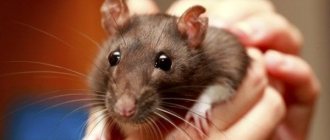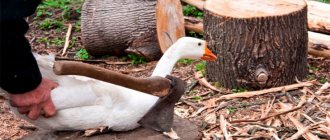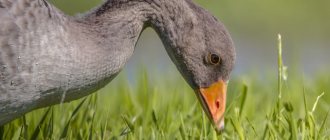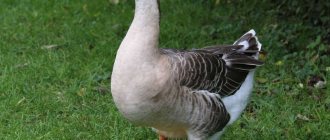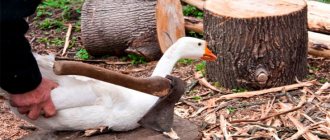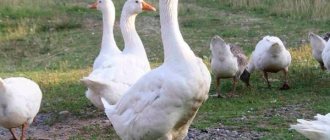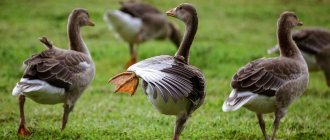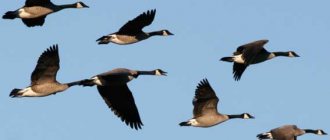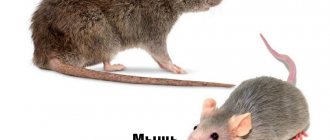The sexual dimorphism of an adult bird is pronounced, so this issue usually does not cause difficulties even for beginners. But young individuals, especially chicks up to a month old, are practically indistinguishable from each other, and at such moments some poultry farmers are faced with the difficulty of determining the sex of goslings. Let's look at several ways to distinguish a goose from a goose at different ages.
Pronounced differences between males and females at an early age practically do not appear
The value of the ability to determine the sex of geese
Purpose of breeding: increasing the number of domestic geese. There is no point in buying a random number of males or females, because reproduction must be competent. Goose farming, like any other poultry farming, requires a stable increase in the number of individuals. Animals inevitably die and are replaced by a new generation. To ensure that production does not stop and profits do not decrease, it is necessary to ensure the availability of not only ganders, but also geese.
domestic goose
In addition to reproduction, competent sexual selection also pursues the following goals:
- Increased egg production. The eggs are laid by females. An excessive number of goose will have a negative impact on the final number of eggs.
- Abundance of meat. According to statistics, males weigh about 25% more than females.
- Sale of goslings. Before sale, clients require information about the gender of the individual. Hiding or not knowing the gender of the gosling will negatively affect the deal.
In other words, it all depends on the tasks that the poultry farmer has set for himself. If you plan to produce meat, then it is wiser to purchase and breed males, but if eggs are required, then it is worth increasing the number of geese.
Selling goslings at the market
The enormous experience of goose breeding has led to the formula: one gander for four geese. This golden mean will bring the greatest possible benefit. There is an optimal level of meat and plenty of eggs.
The relevance of the issue of gender requires a reliable and unambiguous answer. There are many ways to determine the sex of geese. Their effectiveness directly depends on the age of the bird.
Why is it necessary to select a flock of geese based on gender?
If the herd is formed correctly by gender, this affects a number of indicators:
- Meat production . If geese are bred for meat, the flock should consist primarily of ganders. The goose is much larger, it has more meat and fat, therefore, the yield of marketable products is higher.
- Egg production . When forming a herd, leave one goose for 4 geese. If there are more males, egg production in the herd will drop significantly. If you purchase young animals without determining the sex of the chicks, the individuals will mix, as a result of which this will negatively affect the egg production rate.
- Production of strong offspring . To get healthy offspring of goslings, you need to keep a large and strong male in the herd. Such a “producer” will produce chicks with the same physiological qualities.
- Chicks for sale . When selling young animals, you need to professionally determine the sex of the chicks and know how a gander and a goose differ. If a manufacturer carefully selects chicks based on gender, this will provide him with reliable and regular customers, as well as stability in the development of the poultry business.
Methods for determining sex at an early age
Things are more complicated with chicks than with adults. There are several reliable methods. Among them, special attention is deserved:
- Scientific. Knowledge about the peculiarities of the biological structure of birds is used.
- "Bungee"
- Fright. The bird must be scared with a sharp sound and monitor its reaction.
- Degree of activity.
- Dimensions.
Goslings of different sexes
Each method has its own characteristics. It is necessary to analyze them in more detail.
Scientific method for determining the sex of goslings
This scientific method, also called ventsexing, is widespread. The step-by-step instructions are as follows:
Step 1. Place the gosling on its back. In this case, the chick's head should hang slightly, and the tail should reflexively rise.
Step 2. We look at the opened cloaca (anus), in which the red genitals are located.
Step 3. The presence of a small appendage directly indicates that the chick is a gander. Due to its small size, the penis is sometimes difficult to see. Solution to the problem: use special magnifying devices. For example, an ordinary magnifying glass will do.
Step 4. If the shoot could not be found, then it is obvious that the chick is a goose.
There is no doubt about the method. It is based on the peculiarities of the morphological structure of birds and allows you to almost accurately identify a half-gut. The only thing you need is good eyesight.
Bungee
Folk way. Very common among poultry farmers. This is done as follows:
- We take the chick by the legs. We do this carefully. The paws of young animals are thin and tender.
- Carefully turn it upside down.
- We are monitoring the reaction.
Gander or goose?
The reflex developed by nature must work. If the chick tries to reach its body with its beak, then this is a male. If no reaction is observed, and the gosling only turns its head, then it is definitely a female. Of course, one can doubt the effectiveness of the method, because a particular individual can behave completely unpredictably in a stressful situation. The basis of "Bungee" is statistics. This method is popular, but relatively reliable, because behavioral traits are influenced by heredity.
The goslings are frightened
A stressful situation is a great way to identify a female or male. A characteristic feature inherent to gender appears. A simple and effective method. It is necessary to scare the chick with a sharp sound and monitor the reaction. Males stretch their necks and raise their heads. Assess the situation around for danger. Females hug the ground and are quiet.
Note: you should not abuse fear. This will have a negative impact on the young. With excessive intimidation, there is a high risk of developing an unfavorable conditioned reflex, which can have a detrimental effect on breeding.
Gosling activity
Ganders, even at a young age, are very noisy. They almost never get tired. They lead an active lifestyle. This happened evolutionarily. Activity is needed to explore new territories and compete. It is the ganders who are the first to go around the area and the feeding point. Already at an early age, small conflicts for leadership in the pack are noticeable. Females behave calmly and quietly, without showing any signs of aggression. They only speak when hungry or in a stressful situation.
Gosling sizes
Males are usually larger than females. This is noticeable even in an incubator. Ganders walk with their heads raised and chest puffed out. They look around the area and are very curious. The gait is proud and stately. Females, on the contrary, are smaller in size than males. Their head is directed towards the ground.
Behavioral factors
Already in small chicks, differences in behavior are noticeable - from them, with relative accuracy, you can distinguish the sex of geese before they grow up.
Males
Males are more active, loud and conflicting; they are usually the first to rush to the feeder. If you take a small chick by the legs and turn it upside down, it will strive to rise, reaching almost to its belly with its beak.
When carrying out such a test, you need to be careful not to cause harm - when turning over, the back and head of the chick are held with the other hand.
At a sharp sound, the chicks stretch their necks, trying to find the source of danger. Adults, in addition to this, hiss at the offender and try to attack.
When swimming in a pond, geese tilt their heads almost parallel to the water. Coming ashore, they stretch out like a candle, spread their wings and make several active claps. Birds have a proud body posture.
Females
When performing the upside down test, little geese behave passively. They do not strive to rise; they can only turn their heads. Compared to males, females are much more peaceful and calm; they rarely make noise - mainly in the absence of food. Their body posture is squat. When frightened, they tend to hide and hide; they do not show aggression. When bathing, geese keep their heads tilted towards the water.
How to distinguish an adult goose from a goose?
The easiest way to distinguish adults is by using external signs. A careful inspection of the herd will allow you to select males from the herd: in appearance, the “boy” is much larger than the female.
In addition, an adult male weighs about 10 kg, and smaller geese weigh about 5 kg.
Take a close look at the neck of the birds: in males it is thick and long. In addition, the gander's head is larger than that of the goose. Despite the simplicity of determining the sex of birds by external characteristics, this method is not always accurate and effective.
Experienced owners can distinguish a flock by gender by analyzing the behavior of the birds. Males are known for their rambunctious nature as they are alpha dogs by nature. You can recognize a female by her calm behavior; she rarely gets into fights.
During the mating season, ganders clearly stand out in the herd, as they begin to fight among themselves for females. They become obnoxious, aggressive and clearly display fighting qualities. At any opportunity, the ganders begin to fight, pinch and push their opponents.
But this method of determination is suitable for a small herd, because if there are many ganders, there will be several leaders, which will lead to chaotic behavior.
Another way to determine the sex of geese is by observing them on the water. While swimming, males stretch their necks upward. In females, the neck is horizontal, and their movements resemble bows over water.
Also, the goose and the goose differ from each other in their voices. Females cackle loudly and protractedly, and males pronounce sounds in a hoarse voice, but loud.
Main Differences
Over many years of work on breed selection and breeding of geese, several popular methods for determining differences between the sexes have emerged. Each of them has its pros and cons, but together they give excellent results. There are also tips on how to distinguish a male from a female by appearance.
Appearance
External signs will definitely appear sooner or later. The surest external sign is the growth of the gander. Even with the same weight, it will be significantly taller than a goose. The male also has a stronger body and a confident gait. The gander's head is larger and its neck is longer.
Often the male beak is less powerful and has a hump, while the female half has a straight or slightly concave beak
However, it is not always possible to determine the sex of birds by appearance, so it is recommended to pay attention to the habits and character
Character and behavior
The character and temperament of geese differs significantly. While geese behave more calmly, quietly and non-aggressively, noisy males try to sort things out and fight for leadership. Anyone who has met a flock of geese in person has seen that the ganders react violently to any obstacle or irritant, hissing and trying to pounce. This is how they protect their females. Also, with any threat or alarm, ganders stretch their necks, while geese, on the contrary, try to draw them in deeper.
At a later stage, during the mating season, the initiative also belongs to the gander: he stretches his neck and tilts his head, and then imitates building a nest. The female only repeats his actions.
100% method of separating geese by sex
To do this, the chick needs to be tipped onto its back so that its head hangs back, while its tail is raised to the top.
Carefully, so as not to injure the gosling, you need to open the cloaca and examine the red genitals. If there is a small shoot, then you have a gander on your hands.
But the difficulty of this method of study lies in the fact that the genital organs are too small in size, so for examination you will have to use a small magnifying glass (loupe). This method of determining the sex of a chick gives the correct result in 80% of cases.
It seems that everything is simple, but during the inspection there is a high risk of injuring the bird or getting injured yourself. Professionals provide detailed instructions for the procedure:
- Having thrown the chick onto its back, the lowered tail must be bent to the bottom. Gently open the cloaca with your index finger and thumb.
- To prevent the goose from escaping, its head should not be pressed too tightly between the legs. Use your fingers to press around the cloaca so that the inner wall of the cavity becomes visible. A small appendage will be the male’s sexual organ.
But this method of determining the sex of goslings or an adult bird is possible with good human vision and the presence of a magnifying glass. It is much easier to distinguish a goose from a geese among adult goslings than among goslings, since the genitals of males grow up to 3 cm.
To increase the likelihood of correct selection, it is recommended to use comprehensive methods and methods for determining the sex of birds.
When creating a poultry house, you need to decide for what purposes you plan to raise geese. The correct selection of individuals and planned tasks will help you achieve your goal, get high-quality meat, domestic eggs, and good profits from running a poultry business.
Gender of chicks
It is much easier to distinguish adult birds, because they often have pronounced external signs, which cannot be said about chicks
But for the further formation of the herd, it is very important to know the number of females and males at the initial stage. This is done by visual inspection
You can distinguish a goose by the presence of a red appendage, which will be visible in the cloaca if you lay the small bird on its back. The head will hang down and the tail will rise. The organ is small in size, so when examining it, it is better to use a special glass for magnification.
Another way is to turn the gosling upside down so that the legs are up. In this position, female geese simply shake their heads, while male geese try to reach their legs, break free, and beat their wings.
There are also peculiarities in the behavior of chicks. Even in the incubator, the “girls” are calmer, more patient, and not as demanding of food as the representatives of the opposite side.
A scientific approach to determining the sex of geese
Currently, the sex of geese is determined using the Japanese method, which consists of identifying the male genital organ in the cloaca. An experienced operator can sort up to 500 birds by sex in 1 hour with an accuracy of 99%. This labor-intensive process on an industrial scale of poultry breeding is ineffective, since the costs of sorting poultry increase and there is a threat of the transfer of infectious diseases.
Poultry farmers are striving to put into practice scientific methods of sexing young geese:
- Genetic method (autosexing) - breeding a population of domestic geese with a special set of marker genes. The basis of color sexing or color sexing is stable color differences in the color of the down, which is different between ganders and geese. Federsexing is a method of determining sex based on the type of wing feathering.
- The probe method was developed in Japan in the mid-20th century. Sex is determined using a telescopic “chick tester” device, which is inserted into the cloaca. The sexing speed is up to 500 birds/hour with a detection accuracy of 98%. The probe method has all the disadvantages characteristic of the Japanese method - low productivity and the possibility of spreading infections.
- Acoustic method - a day-old gosling is held by its legs, head down, in front of a microphone connected to an acoustic analyzer. The device processes the sound of discomfort made by the chick using a special program. If the gander screams, the red light comes on, the gander lights up blue. The green light turns on - the gender is not determined. The detection accuracy with this method is 85–95%.
Today, scientists are working to improve the technological operation for sexing young geese and other poultry.
Interestingly, the peak of gander sexual activity occurs in the morning and first half of the day - from 6 to 14 hours. At this time, up to 92% of attempts to mate are made, both on the initiative of the gander and the goose.
Japanese method
To determine gender, the Japanese method is used. It involves examining the chick's cloaca.
Step by step steps:
- Place the bird on its back. The head should hang down and the tail should be raised.
- Examine the cloaca, which should open. It contains the genitals.
- If there is a small shoot, then the chick is a gander. The size of the process can be so small that it is impossible to see them, so it is worth using magnifying devices.
- If there is no shoot, then the chick is a goose.
Technique for determining sex of goslings
Often, mistakes occur when determining the sex of small goslings.
When determining the sex of goslings when they are small, mistakes often occur. This happens because the gosling's cloaca and penis are the same color - pink. In small geese, thickenings in the form of hemispheres can be seen, the folds of the cloaca are evenly distributed. In ganders, the penis looks like a curved gimlet measuring 3–4 mm; the folds of the cloaca are barely noticeable.
A day-old gosling is taken by the left hand by its paws, which are fixed between the index and middle fingers. The gosling's head is lowered down, its neck rests on its little finger. Holding the tail, open the cloaca with your fingers.
If sorting by sex was not carried out at one day of age, you can do this after a month.
In the cloaca of a male aged 180–200 days, the copulatory organ is clearly visible in the form of a spiral curl, divided into barely noticeable segments. At this age, the copulatory organ is formed in 75% of ganders.
In the goose, in the lower part of the cloaca there is a slightly flattened small bulge that does not have articulations.
Methods for determining sex in geese aged 6–7 months:
- If one person is sorting, he picks up the goose, simultaneously grabbing the legs and wings, and flips it onto its back. In this case, the neck is placed under the left arm, the left wing is held by the elbow. The hands remain free. The goose is placed on the left knee, the tail is bent. Use the thumb and index fingers of both hands to stretch the cloaca.
- An older goose should be held tightly (preferably with two people), placed on the table, with one hand pull the tail towards the back, with the other hand (thumb and forefinger) stretch the anus. The penis is 5–7 cm long, pink, sometimes grayish, and clearly visible.
If it is not possible to quickly determine the sex - the bird squeezes the muscles of the cloaca or actively resists, it should be released and repeated in a week.
The entire procedure is carried out with light, precise, non-traumatic movements.
It is interesting that the domestication of wild geese continues to this day in areas where this bird is widely inhabited. The local population catches the young animals and fattens them. The goslings are well tamed and, with improved feeding, at the age of five months they gain 5-5.5 kg of live weight.
Weights and characteristics
Linda geese are quite large representatives of the waterfowl family. The weight of individual individuals can reach up to 12 kg, with averages of 8 kg for males and 7 kg for geese, respectively.
Chicks enter the period of maturity already at 8 months, while already in the first 2-3 months young goslings gain body weight of approximately 4 kg. The meat of Lindov geese has proven itself to be excellent due to its softness and delicate rich taste.
These factors make Linda a leader among meat breeds of waterfowl. The species is characterized by relatively high egg production.
Egg production of the Lindov breed
These are the eggs Linda geese lay
The number of eggs from one hen ranges from 50 to 65 eggs per year and occurs in the spring. The weight of one egg is about 150-170 g. More than 90% of all eggs are fertilized.
Under incubator conditions, the viability of eggs is in the range of 70-80%. Of the hatched goslings, at least 90% of the chicks reach maturity. Partly, such indicators are the merit of female individuals, since Linda geese are also excellent hens.
One of the keys to egg production is the females consuming sufficient amounts of calcium and nutritious green food. In combination with long daylight hours, these two factors can achieve high productivity of eggs from this breed, both for consumption and for further breeding.
How to determine the age of a goose?
Zootechnicians do not recommend overexposure to poultry. Long-term fattening (more than 5-6 months) for meat is considered unprofitable. The optimal weight for slaughter is about 4 kg. With age, geese develop a fat reserve, which affects the quality of the meat and ultimately affects the market value. Therefore, the stock of the flock must be updated in a timely manner.
Usually the age of a bird is determined by its appearance. As a rule, young animals look neater and healthier. Knowing some physiological characteristics of geese, you can easily distinguish old from young:
| Options | young bird | old bird |
| Weight | Up to 4 kg | Over 4.5 kg |
| Beak | Yellow | Dark, under the beak - a characteristic plumb line |
| Stomach | Round | Stretched across with pronounced sebaceous deposits |
| Legs | Smooth, shiny, with thin swimming membranes | Scaly with rough swimming membranes |
| Plumage | Feathers are located close to each other, the skin and feathers are light in color | The plumage is loose, darker |
Bird species
Geese have long lived side by side with humans and are considered a symbol of prosperity by many peoples. Ornithologists are confident that modern domestic birds are descended from several wild breeds. In particular, Charles Darwin said that the ancestors of cackling birds are the gray goose and the swan goose.
In the modern world there are 63 breeds of this bird.
Bird species vary in size, each of which is bred for specific purposes. There are large, medium and small. Individuals of the first category most often appear on large farms. They are considered the most unpretentious and quickly adapt to any living conditions.
Medium-sized geese are found on individual property - people keep them for their own needs. And small breeds are decorative representatives of waterfowl.


